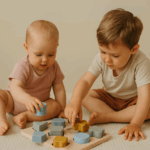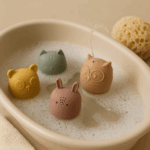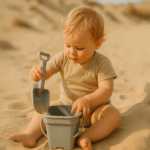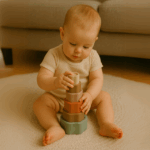Puzzling is not only a fun and relaxing activity, but it also offers numerous benefits for young children's development. For parents, it can sometimes be difficult to decide from which age puzzles are suitable and how many pieces a puzzle should have. In this blog post, we dive into the wonderful world of puzzles for children aged 2 to 6. Read on to discover how to introduce your little one to this engaging activity!
Why is puzzles good for children?
Puzzling is much more than just a game. It helps children develop important skills. First, puzzling promotes fine motor skills. When children pick up small pieces and put them in place, they improve their hand-eye coordination. It also encourages problem-solving skills, as children have to think about how the pieces fit together. Finally, puzzling promotes patience and concentration. Children learn to persevere until they complete the puzzle, which increases their self-confidence.
Puzzling with toddlers (2-3 years)
For toddlers, puzzles are an excellent way to stimulate their curiosity and urge for discovery. At this age, children are often fascinated by shapes and colours. It is important to start with simple puzzles that have large, sturdy pieces. Puzzles with four to nine pieces are ideal for this age group.
Choose puzzles with recognisable objects or animals, so the child can identify with the images. The success of solving a puzzle can grow their self-confidence and encourage them to take on new challenges.
Puzzling with preschoolers (4-5 years)
As children get older, they can handle more complex puzzles. For preschoolers, puzzles with 12 to 24 pieces are suitable. These puzzles may offer a little more challenge, but should still remain clear enough to avoid frustration. At this age, children begin to recognise patterns and details, which helps them complete puzzles. It is also a great way to develop their social skills, especially if they puzzle with others. Preschoolers can learn to work together and help each other solve problems.
Puzzling with school-age children (6 years)
Once children start school, they can enjoy even more challenging puzzles. Puzzles with 50 to 100 pieces are ideal for this age group. They can now create puzzles with more complex pictures and themes, such as landscapes or scenes from their favourite books or films. School-age children can also benefit from the educational value of puzzles. They learn logical thinking, spatial awareness and planning strategies to solve the puzzle. Moreover, it can help improve their memory and attention to detail.
How to choose the right puzzle?
Choosing the right puzzle for your child is essential to spark their interest and motivate them to keep going. Consider your child's age, skill level and interests. Check the recommended age range on the box of the puzzle, but also trust your own judgment. Observe how your child responds to different types of puzzles and adjust the difficulty level accordingly. Remember to put fun first. Children learn the most when they enjoy what they are doing!
Puzzling as a family activity
Puzzling does not have to be a solitary activity. It can be a great way to spend quality time with the family. Organise a puzzle afternoon where everyone works together to solve a larger puzzle. This not only fosters bonding between family members, but also provides an opportunity to interact and work together. It can also encourage children to be proud of their achievements when they have successfully completed a puzzle.
 Puzzles
Puzzles Water toys
Water toys Role-playing toys
Role-playing toys Sand toys
Sand toys